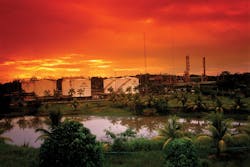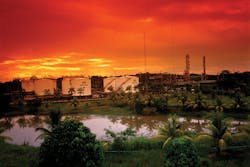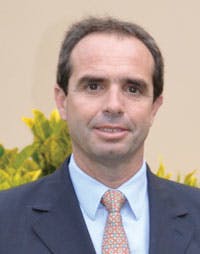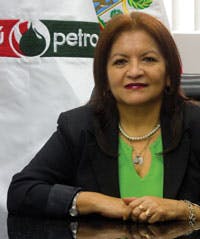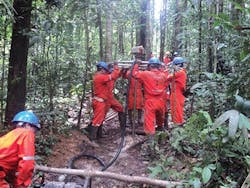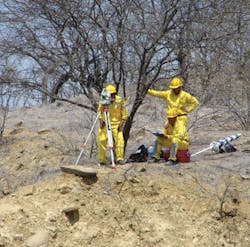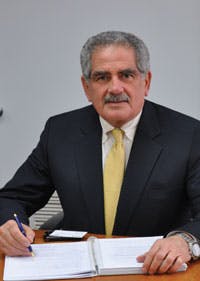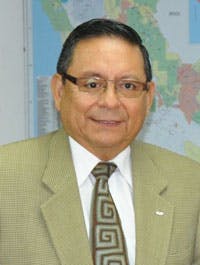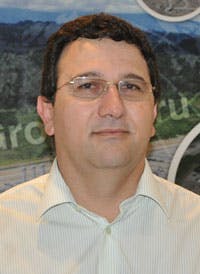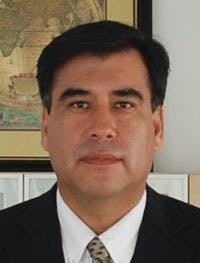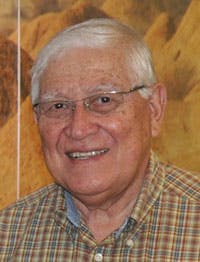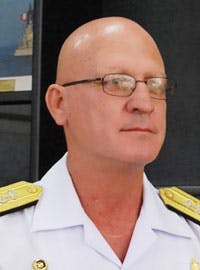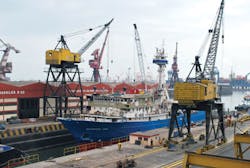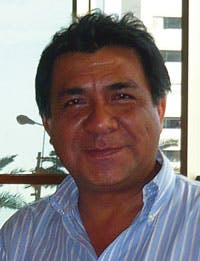Peru Oil & Gas: The Modern Inca Gold
| This sponsored supplement was produced by Focus Reports. Project Director: Henrique Bezerra, Project Coordinator: Mariuca Georgescu, Editorial Coordinator: Leonardo Barquero. For exclusive interviews and more info, please visit energy.focusreports.net or write to [email protected] |
As a country surrounded by mysteries and enigmas; dotted with kilometers-wide geoglyphs only seen from the sky; with dozens of deserts and the lush Amazon; from the depths of the Pacific Ocean to the Andes' 6000m heights – Peru's luring mystique is undeniable. For centuries, this country has enticed opportunist explorers with tales such as the lost city of El Dorado. Nevertheless, Peru's new explorers are now searching for something much more intangible and precious: energy.
As Latin America's seventh largest economy and a market of 30 million people, Peru has been the continent's fastest growing market in the last five years, expanding more than 8% in 2010. This growth has aggravated the need for energy resources. Since the discovery of the 11 trillion cubic feet of natural gas and 482 million barrels of natural gas liquids in the Camisea field in 1986, Peru has increasingly shifted its energy grid so that hydrocarbons play a greater role in fueling the country. Such discoveries, together with an assertive government plan to attract foreign capital, have boosted investor confidence in the country as much as it has laid the ground for an emerging Peruvian industry ready and able to study, explore, extract, transport and market its own natural resources. While some investors were uneasy with the election of left-wing presidential candidate Ollanta Humala in June 2011, the majority of them are confident that the new President will not interfere in the country's economic policies that have allowed for its impressive economic performance over the last decade. Furthermore, while the rush for the new "Inca gold" has been expeditious it definitely has not been careless.
Natural Gas: a modern Peruvian gold rush
After two decades of market deregulation, privatization, financial discipline and trade openness, particularly in the hydrocarbon sector, Peru seems to be once again close to reach its self-sufficiency status lost in the early 1990s. "One of the main objectives of Peru, as all countries, is to have energy self-sufficiency, especially now during times of such high volatility. The national demand is getting close to 200 bpd - right now Peru is consuming around 186 thousand bpd… I'm confident we can supply this demand in a few years with the current speed of discoveries" explains Luis Gonzalez Talledo, director general of the General Directorate for Hydrocarbons (DGH), which serves as Peru's regulator for the oil & gas sector. Private and public sectors alike have taken upon themselves to develop and exploit the country's natural resources as efficiently as possible to turn Peru into an energy self-sufficient nation. These efforts have surely paid off allowing the country's largest natural gas reserve to be exploited and marketed to serve not only the local market, but also those of neighboring countries and beyond. With Latin America's first LNG mega-terminal and suspected gas reserves far beyond those of Camisea, Peru is ready to reap the benefits of its new prized commodity well into the future.
The revamping of Peru's hydrocarbon industry began in the 1990s when it was decided that the NOC, Petroperu, was too inefficient to adequately manage the hydrocarbon demands of the country. It was during this period that the company's upstream activities were sold off and privatized while it focused on is commercialization and distribution activities. Parallel to this privatization the Peruvian government began an overhaul of the legal and regulatory frameworks that would become the backbone of today's flourishing industry. In 1993 "it was decided to create an independent organization – Perupetro – solely in charge of promoting, negotiating, subscribing and supervising the license contracts between oil and gas companies and the Peruvian State", describes Isabel Tafur, today's general manager of Perupetro. That same year a new legal regime was established as the basis to attract foreign investors with pockets deep enough to tap into Peru's unexplored hydrocarbon areas. Tafur is proud to elaborate that "the hydrocarbon law gives a lot of guarantees to investors. The signed contracts are law-binding; they ensure tax stability and exchange rate guarantees, as well as guarantees of remittance of foreign currencies by the Peruvian Central Bank and tax return on investments in exploration". Furthermore, Perupetro has taken upon itself to become a proactive agent in luring foreign capital by promoting the country's indefinite potential in oil capitals around the world, such as Houston and London. This year the organization will launch a bidding round for up to 25 exploration blocks that will push the total number of blocks in the country beyond 100, compared to the original 21 that existed when Perupetro was first created. "These blocks offer high prospects for gas in the South, with important on-going projects and new discoveries such as the ones from Petrobras in blocks 57 and 58" concludes Tafur.
One company the bet early on Peru to find immense returns is that of Argentine Pluspetrol, who in 2000 led the consortium that would explore the Camisea gas fields that are the country's hydrocarbon pride and joy. Initially discovered in 1986 by Shell, Camisea is estimated to contain over 11 trillion cubic feet (TCF) of natural gas reserves and is the source of natural gas for the country's LNG mega-terminal, which represents Peru's largest investment (US$ 3.8 billion) into a single infrastructure project and the only terminal of its kind in the region. Located deep within the Amazon jungles of Peru, the extracting, transporting and distribution of Camisea's gas was no easy task and required the expertise and financial backing of several companies. For the upstream, Pluspetrol joined forces with Hunt Oil from the USA, SK Corporation from South Korea and Tecpetrol (owned by Techint) from Argentina, while the transportation concession was headed by Tecgas (owned by Techint) and also included Pluspetrol, Hunt Oil, SK Corporation, Sonatrach and Graña y Montero. The transportation concession involved the construction of two 540 kilometer pipelines, one for natural gas (NG) and the other for natural gas liquids, from central Peru across the Andes Mountains and ending at a terminal in the city of Pisco on the Pacific coast. Additionally, the concession required that the gas be transported and distributed to Lima and the main port-city in the country, Callao. This required the construction of a second 714 kilometer pipeline that carries the gas along the coast to Peru's capital. Roberto Ramallo, general manager of Pluspetrol, says that "Camisea represents for Pluspetrol the most challenging project to be accomplished by the company. Logistically, the project was truly a test because of the lack of roads and having to transport everything via rivers or by air". Today Pluspetrol is the largest hydrocarbon producer in the country and counts on its Peruvian operations for 70% of its global revenue.
Camisea was symbolic for the country in many ways as it marked a turning point for Peru's hydrocarbon industry. It was because of this and other NG discoveries, as well as a diminishing petroleum production, that the country decided to shift its energy matrix to focus on natural gas rather than petroleum derivatives. Before Camisea, Peru relied on petroleum to supply 69% of its energy needs while natural gas only represented 7% and other energy sources (hydroelectric, biofuels and renewable sources) 24%. The aim today is to shift the country's energy supply to rely predominantly on natural gas and hydroelectric power, and by 2009 NG and its liquids had already moved to become more than 52.5% of the country's total energy produced while petroleum had decreased to 28.7%. In essence, NG has become the promise of a steady energy supply to the country's booming economy as well as one of the most lucrative commodities comparable to the precious metals that are also sourced from Peru's mineral-rich earth. Guillermo Ferreyros, vice-president of the National Association for Mining, Petroleum and Energy (SNMPE), explains that "Peru's current economic growth brings higher energy demand. This year alone our hydrocarbons consumption grew at double digits and the natural gas consumption in 2009 was at the level expected for 2016. In order to supply all this energy demand, Peru managed to attract grand investments, such as the $3.8 billion Melchorita LNG plant. Until 2016 this project alone will drive more than $7.5 billion to the country. Thanks to Melchorita LNG Plant the trade balance will be reversed into positive results in the coming years". The colossal project leading to the inauguration of the Melchorita LNG plant in June 2010 was conducted by a consortium of companies known as Peru LNG, headed by Hunt Oil with the participation of SK Energy, Repsol and Marubeni. The world-class liquefaction plant was built by the Chicago Bridge & Iron Company (CB&I) and has an annual capacity of 4.4 million tons of LNG that will be exported to other countries in the region.
While Peru's economic and political stability of the last two decades have allowed for the national oil & gas industry to thrive, this growth has not come devoid of obstacles. Some of the most often-mentioned challenges are the remoteness of Peru's hydrocarbon reserves compounded by the lack of a robust local offering of service providers that can assist the E&P companies. The fact that oil & gas reserves are mostly located deep in the Amazon jungle is complicated enough from a logistical point of view, but it also involves environmental and social hurdles for companies. Douglas Reichenbach, general manager of the Andean Region operations of US-based Geokinetics, speaks of the difficulties his company has faced conducting their seismic studies in Peru: "When you look at a map outlining the blocks that were operating in Peru in November 2010 as compared to one of 2007, the difference is simply staggering in the amount of new blocks that have been opened for exploration. With that kind of growth of course there will be a lot of challenges, especially when one of our priorities is to maintain the same environmental standards across all of our projects. This is a very time-consuming process and obtaining the environmental permits sometimes takes longer than the actual project. The other challenge of exploration here in Peru is the remoteness of most of the projects and the complex logistics that are required to carry them out". Geokinetics' experience is echoed by the majority of the industry and has highlighted the deficiencies in human capital and industry experts. "If you consider that there are 50 foreign oil companies coming to Peru and each one has their exploration block and each one needs personnel who are experts in the field of environmental affairs; as such, there is a premium for local environmental experts" says Reichenbach.
Building Peru from Oil & Gas
Even though Peru's rapid economic growth, averaging at 6% for the last decade, does not allow for wasted time, the challenges it faces to maintain this pace don't stop once the oil and gas reserves are found. Since most of its discoveries are on the foothills of the Andes in the Amazon rainforest, transporting it through the mountains is a major challenge that requires the construction of an entire infrastructural system to distribute the energy resources of the country. Only ten years ago the local hydrocarbon industry had a deep shortage of service providers to support the needs of the industry as it expanded. Discoveries such as Camisea highlighted the magnitude of the Peru's hydrocarbon wealth and were the catalyst for a local oil & gas service industry to develop. Even though the situation still has much room for improvement, Peruvian and international companies alike have taken on the challenge and created a robust service offering to ensure the sustainability of the industry.
At the forefront of modernizing the industry's infrastructure to meet present and future demand is NOC Petroperu who was originally the sole operator in the country prior to the privatization of its upstream activities. Its history is representative of the different phases the sector has gone through. "In 1988 Petroperu was the company with highest losses in Latin America. But the reforms were so profound that the company soon became one of the most profitable organizations in the region. In 1993 we managed to meet ends and in 1994 Petroperu already became the most profitable company of Peru", explains Gustavo Navarro, manager for production and planning at Petroperu. Today the company is driving its growth by modernizing essential infrastructure that is decaying, from its refineries to its pipeline transportation system in the north of the country.
Greening Peru's Growth
As Peru races through its development, the government has made sure that this growth is mindful of the cultural, social and natural wealth of the country. Particularly for the oil and gas industry, heavy environmental regulations have been imposed and any kind of project, from a seismic study to the drilling of a well, needs to submit an environmental impact study (EIA) to local authorities. In fact, many companies feel that governmental approval for EIAs is too prolonged and can be a major source of delays. Indeed the government seems to be overwhelmed with the number of EIAs it has to process, most of them related to the hydrocarbon and mining sectors, which highlights the need for companies to hire their own environmental experts that can work through the system as nimbly as possible.
External consulting firms, such as Walsh and Golder Associates, were quick to identify the demand for these kinds of services and are today some of the industry's most reliable environmental specialists. Rafael Davila, managing director of Golder Associates in Peru, explains that "the directorate in charge of EIA for oil and gas projects is a professionally managed directorate, but we should keep in mind that it takes care not only of oil and gas, but other energy subsectors like hydro, thermal and petrochemical projects…finding the right balance between the wishes of the private companies and their investors and the needs of the government and the communities of stakeholders is always very difficult, and this is where we stand providing our best services to our clients." With operations in every continent in the world and over 7000 employees, the Lima office for Golder Associates has become the biggest office in the Latin American region in terms of head count with a total of 320 employees and one of the largest providers of ground engineering and environmental services to the sector. They have participated in flagship projects such as the Camisea pipeline and Melchorita LNG plant and continue to grow in parallel to the country's economy, always with the aim to ensure the sustainability of Peru's boom. As a Peruvian himself, Davila concludes that "despite the outcome of the presidential elections and the uncertainty this brings, I think this country will continue being open to investments because this is the mind framework we Peruvians have had in the last centuries or millennia and that we still share today."
One of their most significant renovation projects is that of its Talara refinery that was originally built in 1917 as one of the first refineries in Latin America and the main source of fuel in Peru. The principal objective of the Talara modernization project that begun in 2010 "is to produce cleaner diesel and gasoline with higher quality and environmental standards, which currently are mostly imported into Peru", according to Miguel Celi, general manager of Petroperu. With an estimated $1.3 billion being invested in the project, Talara will increase its production capacity from 65,000 to 95,000 bpd and will allow for the processing of heavy crude oil which is increasingly being discovered in the northern part of the country. Yet, the company's most daunting task ahead is to upgrade the Norperuano oil pipeline that extends 1100 kilometers from the northern jungle to the coast. "Regarding the modernization of the Norperuano pipeline, this is one of the most complex pipeline projects worldwide. More than thirty years since its construction, this is an asset that must be modernized so that we can also transport oil with other characteristics from newer fields", states Celi. Until very recently processing this heavy oil was not profitable, but thanks to increasing discoveries, greater capital opportunities and higher oil prices, Peru is now expecting to use this petroleum.
The assessment study of the Norperuano modernization was conducted by American Mustang Engineering that is a part of the greater Wood Group. The group has been adapting itself to the needs of the Peruvian market by offering complete service solutions to its clients and bringing new technologies to the market. "That's why we are here, to help with the development of Peru's greatly needed oil and gas infrastructure, bringing new technologies and expertise to this booming but still greatly unexplored market", says Wood Group Peru general manager Carlos Lozano. There are very few companies in Peru that can offer integrated support to the oil & gas sector, and Wood group is betting that this will set them apart from their competitors. "The advantage we have over the competition is clear. It is difficult to find a company in the world with all the capabilities the Wood Group has as a one-stop-shop. But that is not enough. The Wood Group tries hard to be tuned with our client's needs". Having been a part of the Peru LNG and Camisea pipeline project, the company's current strategy in Peru "is to revise its relationship with existing clients and assess whether some of our sister companies can add value to our current services or can satisfy an unattended need for the client. The idea is that instead of having three or four companies targeting the same clients, we can work together to offer a single company portfolio", adds Lozano.
In the southern part of the country there are also plans to build a pipeline to spread the hydrocarbon wealth of the country. The South Andean Pipeline project was awarded to Kuntur, a Peruvian company born specifically to develop this project and controlled by Latin Power III, an investment fund managed by energy experts Conduit Capital Partners of New York. Kuntur general manager, Alejandro Segret, details that "at the beginning the South Andean Pipeline was conceived as a natural gas transportation system only, and now it has both gas and liquids transportation systems. As a result, the projected figures went from around $1.3 billion to $2.5 - $3 billion". This pipeline will also be supplied by gas from the Camisea fields , and will extend 1,085 kilometers to bring a new energy source to the regions of Cusco, Arequipa, Moquegua and Puno.
The South Andean Pipeline project is a tall job, standing at 675 miles long and an original estimated cost of $1.4 billion, but not all needs of the industry are of that magnitude. As a matter of fact, it is some of the smaller and simpler odd-jobs that lack service providers. Rafael Ford, corporate representative for Canadian junior player Petrominerales, alludes to a shortage of service providers and concluded that this might be the only drawback of operating in the Peruvian market. "If you look at the long-term perspective for Peru, you will see a lot of positive success waiting. If we get more service companies locally that would be nice, but outside of that, Peru is a very positive place to work", he says.
To fill this gap Corporacion Petrolera (CORPESA) was created in 1992 as a one-man, one-truck operation. Today the company handles everything from engineering and construction, to creating access roads and providing logistics. "Today we are one of the most important construction and logistics providers to some of largest companies operating in the Amazon Jungle basin, such as Pluspetrol, Talisman, Repsol and Perenco. We haven't stopped growing since we began operations and every year we invoice more than the previous one. Just to give you an idea, since I started working for the company in 1998 our yearly revenues have gone from US$1.5 million to an expected invoicing of US$75 million", states CORPESA commercial manager Sergio Puch. While the company's founder recognizes that Peru is not the easiest market to operate in and growth can be difficult to achieve because of small margins, CORPESA still has great ambitions and aspirations for the future. "We would like to become the best oilfield service company for integrated logistics and construction. If we are indeed recognized as such, the rest will come by itself including the clients and the revenues. Ultimately we would like to see CORPESA taking on major infrastructure EPCM projects: gas plants, refineries, etc.", concludes Puch.
In the meantime, while Peru's new hydrocarbon transportation systems are built and modernized the country still depends heavily on maritime transportation to supply its major cities located along the coast. As the country grew and industries such as mining and oil & gas required a local shipbuilder, Servicios Industriales de la Marina (SIMA) stepped up to the plate. SIMA is the country's largest and most successful shipyard and was originally mandated to exclusively serve the Peruvian navy. From tugboats to tankers, as well as the Melchorita marine terminal, this company has expanded to keep up with the demands of their oil & gas clients that rely entirely on the ocean and Amazon waterways to transport their precious cargo. "Our strategy now is to expand into other markets and become a major regional player. We have already begun doing this by building ships for Chile and now for the new Panama Canal. The idea is to add value to the country, and we need to believe that the country's growth will continue far into the future as long as we all believe and bet on it. Some people are nervous because of the results of the recent presidential elections, but I believe that Peru is like the Barcelona soccer team; regardless of whom the coach is, the team will always win", states Jason Saavedra, executive director of SIMA. Furthermore, "the company recently obtained ISO 14000 certification for our environmental standards and OHSAS 18001 certification for health and safety, additional to our ISO 9000 which we've had for several years. Furthermore, SIMA is now implementing a modern ERP program that aims to make us a more streamlined and efficient company".
Just as important as marine transportation, Peru's oil & gas industry is entirely dependent on the network of rivers that extend throughout the Amazon jungle where most exploration blocks are located. H&O Ingenieros is a local company that specializes in waterway engineering and navigability studies and has been hired by the government and E&P companies alike to map out and make the best of Peru's rivers. "I never imagined seeing the kind of growth that the country and the hydrocarbon industry are experiencing today…now the game has changed and I have begun an entire restructuring of the company that will allow us to grow together with the industry," explains H&O owner and general manager Fernando Levano. "Our aim now is to take on more private clients and to expand our business serving the hydrocarbon industry directly", he concludes. Their latest project is ambitious beyond Peru's national borders. "Its aim is to determine the viability of establishing a commercial route between Peru and Brazil through these rivers and covers a total area of 3,500 km. The ultimate aim would be to join the Pacific and Atlantic Oceans by establishing reliable transit routes on these rivers". That would certainly bring Peru closer to its ambitions of regional integration.
More Oil & Gas Financial Journal Current Issue Articles
More Oil & Gas Financial Journal Archives Issue Articles
View Oil and Gas Articles on PennEnergy.com
